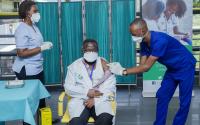[ad_1]
Table of Contents
Unemployment insurance, stimulus tied to less food insecurity
Unemployment insurance was tied to a food insecurity reduction of 4.3 percentage points and a reduction in the need to eat less because of financial constraints of 5.7 percentage points during the COVID-19 pandemic, according to a JAMA Network Open study published late last week.
The researchers looked at 1,119 Understanding Coronavirus in America survey respondents who lived in households with income less than $75,000 and who lost their job during the pandemic.
Overall, 37.1% of respondents reported food insecurity and 39.1% said they were eating less due to financial issues at least once during the survey’s 15 waves. But unemployment insurance was associated with 35.0% and 47.9% relative reductions, respectively, or 4.3- and 5.7-percentage-point reductions, respectively (95% confidence interval [CI], 1.8 to 6.9 and 3.0 to 8.4).
Those who received the additional $600-a-week supplement provided by the Coronavirus Aid, Relief, and Economic Security (CARES) Act or had larger unemployment insurance payments saw greater reductions in food insecurity. No significant changes were associated with the one-time federal stimulus payment or Supplemental Nutrition Assistance Program payments, the researchers said.
The survey results showed that 69.2% of indigenous respondents, 52.5% of Hispanics, 42.2% of blacks, and 40.3% of Asians in this lower-income, unemployed subgroup had food insecurity compared with 26.9% of whites. Additionally, 46.1% of households with food insecurity had children versus 32.8% of households without children.
“The study by Raifman et al adds to our general understanding of unemployment insurance as not only a particularly important tool for blunting the effects of economic downturns but also a tool to promote better health outcomes,” writes Elizabeth Rigby, PhD, in a commentary.
Study lead author Julia Raifman, ScD, adds in a Boston University press release, “There has long been a need to improve the proportion of people covered, the duration of coverage, and the amount of coverage in our unemployment insurance system. This paper speaks to the critical role that unemployment insurance can play in preventing people from facing food insecurity during a crisis.”
Jan 29 JAMA Netw Open study
Jan 29 JAMA Netw Open commentary
Jan 29 Boston University press release
Pfizer COVID-19 vaccine likely effective against B117 variant, study shows
The Pfizer/BioNTech COVID-19 vaccine is likely effective against the B117 variant, according to 40 blood samples that were introduced to pseudoviruses of both the B117 and the original SARS-CoV-2 strains.
The study, published late last week in Science, found that, while the BNT162b2 vaccine was shown to be slightly less effective against the B117 strain, sufficient antibody activity existed for the vaccine to work.
The researchers used blood samples from 26 people aged 23 to 55 years and 14 people aged 57 to 73 years, all from German phase 1/2 clinical trials. All volunteers had received both vaccine doses at the recommended 21 days apart.
SARS-CoV-2 pseudoviruses were introduced either 7 or 21 days after the second dose, and then 50% neutralization assays were used to test the blood samples. The younger group showed 0.78 geometric mean ratio titers against B117 (95% CI, 0.68 to 0.89) compared with the original virus strain, and the older group showed 0.83 (95% CI, 0.65 to 1.1).
“Based on experience from studying antibody correlates of disease protection for influenza virus vaccines, a 20% reduced titer does not indicate a biologically significant change in neutralization activity,” write the researchers. They add, however, that specific vaccine adaptations should be made to combat new strains.
Jan 29 Science study
WHO snapshot covers 4 most recent Saudi MERS cases
The World Health Organization (WHO) today posted an overview of four MERS-CoV cases reported from Saudi Arabia in the last 7 months of 2020, all of which were noted earlier by Saudi Arabia’s Ministry of Health.
In a report that fleshes out more details, the WHO said one of the four cases was fatal. Two of the patients are from Riyadh, and the others are from Taif and Al Ahsa. All are men, ages 40 to 62, and all had underlying health conditions, three of them with diabetes.
No clusters were reported, and none of the patients were health workers or had reported contact with earlier cases. Three had contact with camels or exposure to camel milk.
The WHO emphasized that testing capacity for MERS-CoV (Middle East respiratory coronavirus) has been severely affected in many countries due to resources dedicated to COVID-19, which is also caused by a coronavirus. The agency said it expects additional MERS cases to be reported in the Middle East and that illnesses will likely be exported to other countries.
Since 2012 when the virus was first detected in humans, 2,566 lab-confirmed cases have been reported to the WHO, along with at least 882 deaths. Saudi Arabia has been by far the hardest-hit country.
Feb 1 WHO statement
Study shows oral HPV detected in 22.8% of newborns
New data published late last week in Emerging Infectious Diseases adds to the understanding of human papillomavirus (HPV) carriage in children, showing that HPV can be detected in 22.9% of newborns at birth, but prevalence drops to 8.7% at 3 years.
The data come from a longitudinal study of 331 Finnish children who participated in the Finnish Family HPV Study, which explored nonsexual and vertical transmission of HPV from mothers to babies. Women were enrolled at a minimum of 36 weeks into their pregnancy and were subsequently followed up for 6 years. Researchers conducted oral scrapings on children for HPV testing.
The researchers found 18 different HPV genotypes in the oral mucosa of the children tested, with HPV16 the most prevalent genotype, followed by HPV18, 6, 33, and 31.
The team noted that 22.9% of oral samples collected at birth were positive for HPV DNA,15 HPV types were identified (the most at any point), and the frequency of multiple-type infections was also the highest, at 3.7%. At the 36-month visit, only 8.7% of the oral samples were positive for HPV, and the researchers identified only 4 genotypes. By the 6-year visit, HPV prevalence rose again to 20.4%, and 8 HPV genotypes were identified.
Mode of delivery had no association with HPV carriage, but oral HPV persistence during the 6-year follow-up period was predicted by oral HPV infection and seroconversion to high-risk HPV of the mother during the follow-up period, the authors concluded.
Jan 29 Emerg Infect Dis study
H5N1 avian flu reported in Africa and India, H5N8 and H5N4 elsewhere
Among several new highly pathogenic avian flu developments, Mauritania reported an H5N1 outbreak in pelicans, not far from where H5N1 was recently reported in neighboring Senegal in poultry and wild birds, according to Reuters.
In other detections involving H5N1, India reported more H5N1 outbreaks, in poultry, according to notifications from the World Organization for Animal Health (OIE). One involved backyard birds in Chattisgarh state in the central part of the country and the other at a farm in Maharastra state in south-central India. Also, the country reported H5N1 in wild geese in Punjab state in the north.
Meanwhile, countries on two continents reported more H5N8 outbreaks in poultry, and Germany detected H5N4 for its first time in wild birds. South Korea reported 14 more H5N8 outbreaks in poultry, many at layer farms, in five provinces, mostly in Gyeonggi province. The outbreaks began from Jan 18 to Jan 28, and, taken together, the virus killed 1,993 of 2,241,110 poultry. India also reported more H5N8 in poultry in two states, Gujarat in the far west and Kerala in the far south.
In Europe, the United Kingdom reported an H5N8 outbreak at a game farm housing pheasants in Wales that began on Jan 24; so far, the source of the virus is unknown.
And finally, Germany reported its first appearance of H5N4, which involved a wild swan found dead on Jan 7 in Baden Wurttemberg state in the southwest.
Jan 31 Reuters story
Feb 1 OIE report on H5N1 in India’s Chattisgarh state
Feb 1 OIE report on H5N1 in India’s Maharastra state
Feb 1 OIE report on H5N1 in Indian wild birds
Jan 29 OIE report on H5N8 in South Korea
Feb 1 OIE report on H5N8 in India’s Gujarat state
Feb 1 OIE report on H5N8 in India’s Kerala state
Jan 29 OIE report on H5N8 in the United Kingdom
Jan 28 OIE report on H5N4 in German wild swan
[ad_2]
Source link












